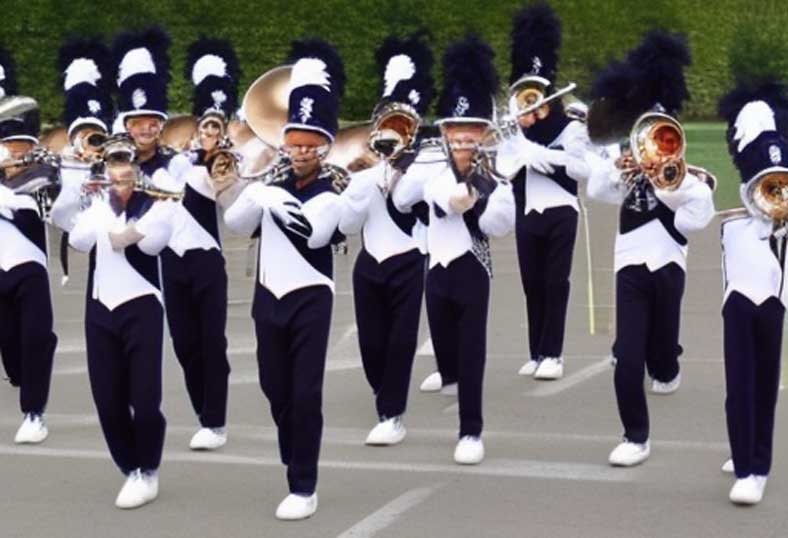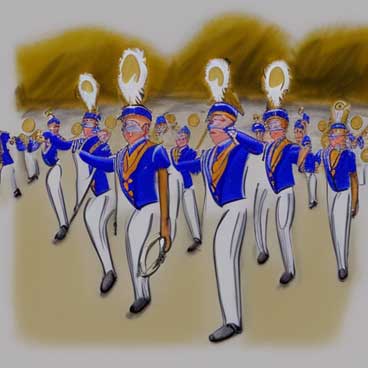
Overview of Jannisary Marching Bands
The jannisaries were the elite infantry of the Ottoman Empire. The term “janni”, or “janissary”, comes from the Ottoman Turkish word “yeniçeri”, which means “new soldier” or “new recruit”. The jannisaries were all originally conscripted when they were young boys, and grew up as soldiers. The original jannisary marching bands were formed by Sultan Mehmed II as a way to keep his troops entertained and motivated. The Ottoman military was an incredibly powerful force, and the jannisaries were one of the strongest elements within it. The Ottomans were one of the most powerful empires of their time, and the jannisary marching bands played a key role in maintaining the military strength of the empire.
Origin of Jannisary Marching Bands
It is widely believed that the original jannisary marching bands were created by Sultan Mehmed II in the 15th century. The precise date of their creation is unknown, but Ottoman records indicate that they played a role in the Battle of Ankara in 1402. It is thought that the Ottomans used the marching bands to inspire troops and entertain the Sultan and his court. The bands played as the Ottoman army marched into battle, and also played pieces in the Sultan’s court. The music was originally based on Turkish folk songs and melodies, but as the Ottoman Empire expanded, so did its musical repertoire, drawing from Balkan and Middle Eastern music.
Over time, the Ottomans ruled over a large portion of Eurasia and Southwest Asia, including parts of Eastern Europe, the Middle East, and North Africa. The Ottomans completely transformed their empire from a small Turkish principality into a sprawling and culturally diverse empire. During this period, the Ottomans drew upon many different styles of music, including Persian, Bulgarian, and Greek music, as well as music from other regions within their own empire. The jannisary marching bands played a big role in the cultural integration of these diverse regions into the Ottoman Empire.
Expansion of the Ottoman Empire and its Impact on Jannisary Music
As the Ottoman Empire expanded, so did the musical repertoire of its jannisary marching bands. The music of the jannisaries was influenced by the regions that they conquered, as well as the cultures that they absorbed. The Ottomans ruled over a culturally diverse empire, which meant that the music of their jannisary marching bands was also culturally diverse. The influence of Balkan and Middle Eastern music on the musical repertoire of the jannisaries was particularly strong. Many of the musical instruments used in the Balkans and the Middle East were adopted by the Ottoman Empire and became a part of the jannisary marching bands. The Ottomans also drew upon the musical traditions of their new subjects, often incorporating a wide variety of instruments into the music of the jannisary marching bands. The music of the jannisary marching bands was also influenced by the geographical location of the Ottoman Empire, which spanned a wide range of climates and environments. Since the Ottomans were expanding into new regions, the musical repertoire of their jannisary marching bands also needed to expand to include music from these diverse regions.
Evolving Musical Styles of Jannisary Marching Bands
After the Ottoman Empire began expanding, the musical repertoire of its jannisary marching bands also began to expand. The Ottomans incorporated a wide variety of musical styles into the music of their jannisary marching bands. The most significant style that entered into the music of the jannisaries was Balkan music. The Ottomans even hired Bulgarian musicians to join their jannisary marching bands. Another important style that entered into the music of the jannisaries was Middle Eastern music. The Ottomans were very aware of the musical traditions of the Middle East, and incorporated many of these musical styles into the music of their jannisary marching bands. The jannisary marching bands also drew upon musical styles from other regions within their own empire, including Greek, Armenian, and Jewish musical styles. The musical styles that the jannisary marching bands adopted were often a combination of cultures. The musical styles that entered into the music of the jannisary marching bands were often blended together with Turkish and Ottoman music.
Modern Uses of Jannisary Marching Bands
The influence of the jannisary marching bands has endured throughout history, and the musical style of these marching bands is still used in many modern settings. There are some modern marching bands that draw upon the musical styles of the jannisary marching bands. These marching bands are a modern form of jannisary music, and have also been referred to as “janissary bands”. Some of the instruments that were used in the Ottoman Empire can still be found in modern marching bands, including the davul (a type of drum), the ney (a type of flute), and the kemence (a type of stringed instrument). The Ottoman military tradition of using jannisary marching bands is still in practice in some modern armies. The British army, for example, has a marching band that performs at military ceremonies. The United States Marine Corps also has a marching band that performs at special events.
Influence of Jannisary Music on Modern Music
The jannisary marching bands were one of the most dominant cultural forces during the Ottoman Empire. The music that the jannisaries played was heard by many people throughout the empire, and the style of the music was adopted by many other cultures. Over time, the musical style of the jannisaries was adopted by many cultures and remains present in modern music. Balkan music has a significant influence on some modern genres, such as Balkan folk music, Balkan brass, and Balkan pop. Many modern music styles draw upon the musical influence of the Ottoman Empire, including jazz, bluegrass, and blues. Some musical instruments that were used in the jannisary marching bands are still in use today, including the davul, kemence, and ney.
Preservation of Jannisary Music
The unique musical style of the jannisary marching bands has survived for many centuries, but the music that was popular during the Ottoman Empire is now rarely heard. The musical traditions of the Ottoman Empire are rarely played in modern times, and the majority of the musical repertoire of the jannisary marching bands is no longer used in music. Although many of the musical styles that entered into the music of the jannisaries are still used in modern music, they are rarely heard in their original form. Many of the instruments that were used in the Ottoman Empire have since been replaced by modern instruments. However, some musicians have taken an interest in the musical traditions of the Ottoman Empire, and have attempted to preserve the musical repertoire of the jannisary marching bands.
Conclusion
The jannisary marching bands were one of the most significant cultural forces of the Ottoman Empire. The musical style of the jannisaries was adopted by many cultures and remains present in modern music. The musical instruments that were used in the jannisary marching bands are still used in modern marching bands. Although the musical traditions of the Ottoman Empire are rarely heard in modern times, some musicians have attempted to preserve the musical repertoire of the jannisary marching bands.
